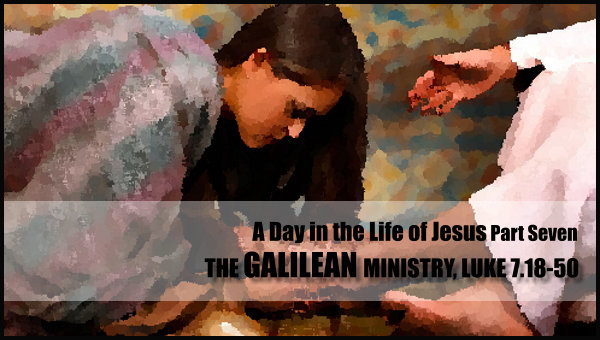By Tyson Thorne

The Galilean Ministry at Various Cities (4.14-9.50), 7.18-50 - A Day in the Life of Jesus, Part Seven
As the day was getting on and the sun low in the sky, the disciples of John the Baptist (who was in prison at the time) came to Jesus to ask a question for their teacher. They wanted to know if Jesus was in fact the Messiah, or if the Messiah were yet to come. Their question was quite direct, yet Jesus didn’t answer their question likewise, answering instead in a cryptic manner leading some (myself included) to believe Jesus may have been communicating more than the answer to their question. Was Jesus speaking in code?
In answer to the question Jesus provides a description of his Messianic works, specifically mentioning that he has healed the blind, the lame, the leper, the deaf, raised the dead and preached good news to the poor. Most Bibles reference several passages in Isaiah that describe the ministry of the Messiah (Isaiah 26.19, 29.18-19, 35.5-6 and 61.1) which aligns nicely with Jesus’ work. All six of these groups are mentioned in the Isaiah passages as are three others: the mute speak, captives are released and prisoners are freed. These passages would have been known to John, and other teachers as well. By describing his work in this way he was answering the question, whether or not he was the Messiah, with an emphatic “yes”!
Why didn’t Jesus mention the other three groups? Doing so would have cemented his answer. Some say that Jesus had not yet healed a mute person and did not free captives and prisoners, but might there be another reason? By omitting the freeing of prisoners could Jesus have been foretelling John’s fate, specifically that he would die in prison? It is an intriguing and, I think, likely possibility.
Jesus then goes on to tell the crowd about John’s ministry and raises a question that has prompted discussion for centuries: was John the prophet Elijah? We’ve discussed this possibility already in our introduction. If you missed it (or do not remember) you may find it here: http://www.think-biblically.com/10-lucubrations/452-luke-introduction-part-1 as we will not re-hash the topic now.
Since the message of John and of Jesus was rejected he told a parable to encourage those who believed in him. He compared “the people of this generation”, i.e. The religious leaders, to children who want to the commoners to follow their lead in dancing and mourning. Since John and Jesus would not partake of the dance (in different ways but for the same reason) they were mistreated and rejected. Those who followed John and Jesus were “wisdoms children” and would be proved right. Coincidentally it is one of these dancing children that invited Jesus to his home for dinner.
Dinners of this kind were common enough in the day, but this one was intended as a trap for the Messiah. A Pharisee invited Jesus to his home for dinner, but did not treat Jesus in the way a guest is normally treated. He deliberately withheld common courtesy’s, such as water to wash one’s feet before reclining at the table for a meal. Only the invited guests were permitted to eat, but all were welcome to enter and listen in on the conversation which explains why a “sinful” woman was allowed entry. The woman, believing Jesus to be the Messiah, came and attended to him and gave him the courtesy and respect he deserved.
The Pharisee’s intent was to prove Jesus was not a prophet, but Jesus knew the religious leader’s thoughts and thereby proved he was a prophet – and more. The meaning of the parable he told is clear enough, and Jesus explains it in case any should miss the point. He then forgives the woman her many sins, but does not forgive the Pharisee his. One fact should be especially noted: it was not the woman’s acts of kindness that saved her, but her love for the Messiah that prompted her actions and enabled her forgiveness. And thus concludes this “day in the life” of Jesus.
Addendum
There is one last item worthy of consideration regarding the sinful woman. The account may sound familiar to the Bible reader, but Luke’s account stands on its own as a singular incident. It has been proposed by some that the Bible contradicts itself stating that this event is reported to happen at a Pharisees home (here in Luke), at Lazarus’ home (John 12) and at the home of Simon the Leper (Matthew 26 and Mark 14). I assure you there is no contradiction as all three episodes are separate events. Noting the differences in the accounts is evidence enough.
|
Luke 7 |
John 12 |
Matthew 26 & Mark 14 |
|
|
Location |
Pharisees Home |
Lazarus’ Home |
Simon the Leper’s Home |
|
Circumstances |
Occurred early in Jesus’ ministry on the day the disciples are chosen. Happened at a dinner in Galilee which was intended to trap Jesus. A “sinful” woman washes Jesus’ feet with her tears then anoints them with perfume from an alabaster jar. The disciples, if present, remain silent. |
Occurred six days before Jesus was crucified. Happened at a celebratory dinner in Bethany in Judea. Jesus’ feet were anointed with perfume of pure nard by Lazarus’ sister, Mary. Judas Iscariot complained about the use of the expensive perfume. |
Occurred two days before Jesus’ crucifixion. No meal is mentioned; happened in Bethany in Judea. Jesus’ head is anointed with perfume of pure nard from an alabaster flask by an unnamed woman. All the disciples complain about the waste; Jesus defends her actions stating she is preparing him for burial. |
While there are similarities between the accounts, the timing, location and other details are different enough to show that they were separate events and not contradictory accounts.
|
|
